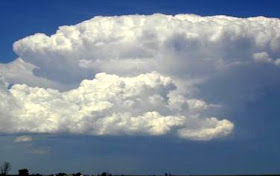I will continue where I left off the other day. Supercells thunderstorms are truly an awe inspiring sight to see up close and personal; the first time I saw one it took my breath away. Supercells are the most likely type of thunderstorm to produce long lived violent tornadoes. As I said, it's the rotating updraft in a supercell that makes it so very different from all the other types of thunderstorms. Various sections of a supercell consist of different types of precipitation. Medium sized hail exist near the gust front with large to giant sized hail in the central section of the storm. This area of the storm is often called the hail shaft. The region where the flanking line meets the storm is where wall clouds and tornadoes normally develop. A flaking line is a line of cumulus clouds that lead up to the main updraft tower. This will often look like steps leading up into the storm. I will go into this in a lot more detail in the next installment. Severe weather is almost always associated with supercell thunderstorms. However, not all supercells produce wall clouds or tornadoes; these can only form when the conditions are perfect.
Types of supercell thunderstorms:
There are three types of supercell thunderstorms: Classic supercells, HP (high precipitation) supercells, and LP (low precipitation supercells). The amount of low level moisture and the value of precipitable water (Precipitable water is the total amount of atmospheric water vapor in a column of air) is the main factor that determines which type of supercell will form.
Classic:
Most supercell thunderstorms are this type . The base of the updraft is very large and normally has a wall cloud. The classic supercell is notable for the dark area of precipitation that it produces, The mesocyclone pulls this behind the wall cloud. Because of this, storm chasers will often try to attack a classic supercell from the southeast to eastern side of the storm; from this vantage point you can get a clear view of the storm. whereas, the west side of the storm will be hidden behind a curtain of heavy precipitation. Classic supercells have varying degrees of straight line winds strength, hail size, and the strength of any tornadoes that are produced. The next blog post will deal with thunderstorm structure, however a classic supercell has the inflow band in the front, the rear-flank downdraft at the rear, and the rain-free updraft base in the center.
A classic supercell
Low-Precipitation Supercell:
LP supercells are sometimes called rear flank supercells. This is because the updraft is located in the rear flank of the cell. Therefore, any precipitation that occurs is away from the updraft. As you can see an LP supercells inflow a lot different than a classic supercell. These cells typically produce very little rain. One thing that makes them particularly dangerous, they can be hard to identify as supercell storms on radar because of their low amount of precipitation. This type of supercell tends to produce very powerful straight line winds and very large hail. However, tornadoes are generally weaker as compared to other supercell types. This is because the forward flank downdraft and rear flank downdrafts are not as well defined. Storm chasers like the LP supercell, because any tornadoes that do develop are very visible due to the light amount of precipitation.
Image of an LP supercell
High-Precipitation Supercell:
This type of supercell is also called a front flank supercell because of the location of the updraft. High precipitation supercells can have so much precipitation that it can surround the updraft as well any accompanying wall cloud. HP supercell are very dangerous to chase, tornadoes are difficult to spot until they are right on top of you. In this type of supercell, hail is normally smaller in association with the other supercell types. However, flash flooding is always a concern due to the tremendous rainfall associated with an HP supercell. The makeup of this type of supercell is very similar to the classic supercell.
Image of an HP supercell
Rebecca Ladd.


















